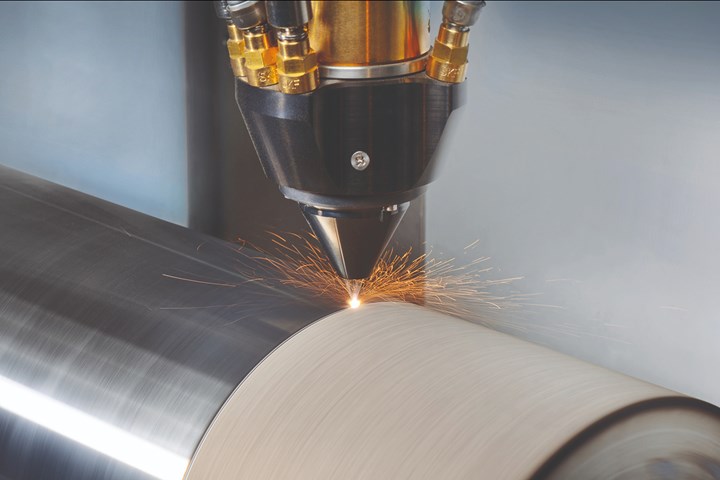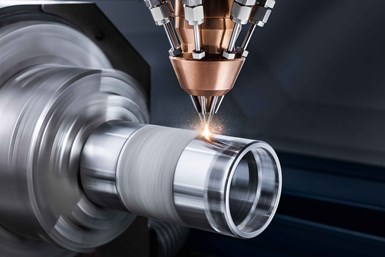
Using a high-speed laser deposition process to coat a roller at up to 200 m/minute. The process allows layers to be applied that are just 25 to 250 micrometers thick.
Photo Credit: Fraunhofer ILTDr.-Ing. Thomas Schopphoven knows more than a little something about extreme high-speed laser deposition (EHLA), a coating process that can provide significant improvements on parts compared to other, more traditional approaches, like laser material deposition or a hexavalent chromium plating.
Schopphoven, who is the group manager Laser Material Deposition, at the Fraunhofer-Institut für Lasertechnik ILT, did his Ph.D thesis on EHLA and is currently heading the team at Fraunhofer further developing the process.
Featured Content
As for the high-speed part of the name: the process is shown to be able to coat a heating roller 1,200-mm long and 200 mm in diameter with a mixture of iron, nickel and cobalt powder at a rate of up to 200 meters per minute. The workpiece is held in a chuck and rotated as the laser moves parallel to the part surface. The thickness of the coating ranged from 50 to 300 µm.
According to Fraunhofer, compared to laser material deposition, EHLA provides a feedrate as much as 250x faster, a 10x coating rate and a 10x reduction in surface roughness (from Rz 100-200 µm to 10-20 µm).
As for the benefit over the hexavalent chromium plating approach, know that during the development of EHLA it seemed as though it was going to be banned by the European Union due to environmental concerns. That ban hasn’t occurred, but companies using the process must get special permission, and Schopphoven notes that “the hurdles to overcome are pretty high” for those working toward getting that permission.
It turns out that while EHLA isn’t particularly good for applying a chromium coating — though it can be used with a variety of materials: iron, nickel, cobalt, ceramics, carbides, among them — in the application that has proven to be highly successful for EHLA, coating hydraulic cylinders for off-shore applications, the material change is beneficial.
Schopphoven says that a nickel-based alloy was used in place of the hard chrome. While the nickel alloy is softer than the chrome, in the application it is more corrosion-resistant and has a higher bonding strength because of the metallurgical bond that is formed during EHLA. So in the application, the service life of the cylinders was actually improved compared to the chrome coating.
What Do You Need?

This powder nozzle from TRUMPF facilitates a coating speed of 600 square centimeters a minute or more — possibly as high as 1,000 square centimeters a minute. This means that there must be high amounts of powder and consequently a laser with sufficient power to melt the powder, such as an 8-kW laser the company has developed. Photo Credit: TRUMPF
“It sounds simple and the principle is simple,” Schopphoven acknowledges, yet there is something to be said for the ability to coordinate and execute the elements in an orchestrated manner to make EHLA work.
First, the laser. “We work with a typical material processing laser, something that is commercially available.”
He says that “diode lasers are great for us.” They tend to be comparatively economical. And they can provide a wavelength of approximately 1-mm, which is what they’re looking for to perform EHLA.
So there’s nothing special about the laser. But this doesn’t mean that every diode laser is applicable.
In terms of power, it is generally application-specific. That is, “We have a customer working with a 4-kW laser, but it only uses 3 kW because they cannot grind the parts produced any faster.” Even if they were coating faster, the finished parts production wouldn’t be any faster because of the grinding capacity.
Schopphoven says that while the output is usually 10 kW or below, going to 12 or even 20 kW is “thinkable.”
The materials are powders commonly used in conventional cladding, thermal spraying and even additive manufacturing.
Then there is a powder feeder. Again, not something exotic. But something that needs to have the precision necessary to move the powder within the diameter of the beam (which, remember, is 1-2 mm) and at “a couple of meters per second.”
How Does It Work?
Although it is based on conventional laser material deposition (LMD), it is different.
That is, in LMD the laser forms a melt pool on the workpiece, then the metallic filler powder is fed in and melts in the pool. This results in a metallurgical bond (there won’t be any delamination, as can be the case with hard chrome plating).
With EHLA, the particles are melted before they reach the melt pool. “They meet the pool as a liquid,” Schopphoven says. “This allows us to go faster.” Faster by orders of magnitude.
The powder is generally propelled by an inert carrier gas, such as argon, nitrogen or helium.
While the process may be simple (use laser to melt workpiece surface; inject melted powder particles; continue), Schopphoven points out that it is important that the parameters are under control in order to assure the melting of the workpiece and the powder. “It takes quite a bit of know-how in order to have the melting of the powder problem within the short interaction time.”
And while on the subject of time, it should be noted that there is a small heat-affected zone (HAZ), on the order of 5-10 µm, as the convection of heat is a time-dependent process and this is occurring quickly. This can allow, Schopphoven says, the coating of a heat-treatable steel onto an aluminum alloy, two materials with entirely different melting temperatures.
Another development that has occurred is the combination of EHLA and thermal spraying.
Schopphoven says that the thermal spraying process, because there is a mechanical bond formed between the coating and the substrate, requires that the surface of the substrate be sandblasted or otherwise activated. All that is necessary for EHLA is that the surface is oil-free.
While EHLA parameters can be adjusted to provide a surface that may not require any post-processing like grinding, it can also be adjusted so as to provide one that lends itself to accepting thermal spray. So if a part is initially coated with EHLA then the thermal spray is put on top of it, while the bonding strength of the thermal spray to the surface won’t be much different than on a non-EHLA-coated surface, if the part is subjected to high loads and bending dynamics, which can lead to thermal spray coating cracking and potential substrate corrosion, with the EHLA coating, even should the thermal spray layer crack, the EHLA layer will protect the part.
Not All Applications

Although EHLA is an advanced process, Fraunhofer’s Thomas Schopphoven says that the equipment, such as the laser, is readily available. It is the execution of the process that makes the difference. Photo Credit: Fraunhofer ILT
Schopphoven says that EHLA isn’t applicable in all cases. “It is an alternative only if the costs are in order and the technological aspects are covered.”
As for the latter, the question is whether the coating meets the requirements of the end use of the part compared to that which can be otherwise applied. For example, he points out that alloys with a carbide content of 80%+ are difficult because of the difficulty of quickly melting the carbide particles.
As for the economic aspect, Schopphoven points out that for galvanic processes there can be a huge bath into which 100 parts are dipped at the same time. EHLA is not a bath process.
But then he points out some other considerations. For example, he notes that a diode laser has good optoelectrical energy efficiency, and galvanic processes require lots of energy.
He notes that EHLA is highly efficient in terms of material use, with some 90% of the powder applied making it onto the part.
But at the end of the day, the question is whether EHLA is applicable taking all of the technical and economic considerations into account.
And if it is, Schopphoven says the result will be “at least competitive—or better.”
No compromise.
RELATED CONTENT
-
What is Electrocoating?
E-coat can produce uniform finishes with excellent coverage and outstanding corrosion resistance.
-
Choosing and Troubleshooting Copper Electroplating Processes
Learn more on this inexpensive and highly efficient process.
-
Fixing Corrosion Between Anodized Aluminum and Steel
Anne Deacon Juhl, Ph.D., with AluConsult, says Galvanic corrosion is due to an electrical contact with a more noble metal or a nonmetallic conductor in a conductive environment.



.jpg;width=70;height=70;mode=crop)
















